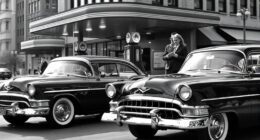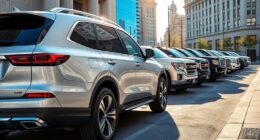If you drive a lot, buying usually makes more sense than leasing since it offers unlimited mileage and greater flexibility. Leasing can be costly if you exceed mileage limits or need extensive repairs, which are common with high miles. Ownership allows you to customize maintenance and avoid penalties. For high mileage drivers, buying often provides better long-term value and dependability. Keep exploring to discover how to select the best vehicle for your extensive driving needs.
Key Takeaways
- Buying offers unlimited miles and flexibility, ideal for high mileage drivers avoiding costly penalties.
- Leasing restricts mileage, and exceeding limits incurs expensive penalties, making it less suitable for extensive driving.
- Purchasing a vehicle typically results in lower long-term costs and better control over maintenance and repairs.
- High mileage increases wear and tear, so ownership allows for customized maintenance schedules and vehicle longevity.
- Leasing may seem attractive initially but often becomes more expensive over time for drivers with extensive annual miles.

If you regularly put thousands of miles on your vehicle each year, you’re a high mileage driver. That kind of usage can substantially impact your decision to lease or buy your next car, especially when considering factors like fuel efficiency and maintenance costs. When your vehicle covers a lot of ground, fuel efficiency becomes more than just a perk—it’s an essential element that affects your overall expenses. A car that gets better miles per gallon can save you hundreds, even thousands, over the years. But it’s not just about fuel savings; high mileage also accelerates wear and tear, which means maintenance costs tend to rise. You’ll want a vehicle that’s durable and reliable, minimizing unexpected repairs and keeping your expenses predictable. Regular maintenance and proper vehicle care are crucial for high mileage vehicles to maintain their performance and longevity.
Leasing might seem attractive at first because it often comes with lower monthly payments and the chance to drive a newer model more frequently. However, if you’re logging a lot of miles, leasing can turn into a headache. Most leases have mileage limits—typically around 10,000 to 15,000 miles per year—and exceeding those limits can incur hefty penalties. This can quickly negate any initial savings, especially if your driving habits are more extensive. On the other hand, buying a car offers the flexibility to drive as much as you want without worrying about penalties, making it more suitable for high mileage drivers. While the upfront cost is higher, owning means there are no restrictions on mileage, and you can plan your maintenance schedule more freely.
Buying offers unlimited mileage and flexibility for high mileage drivers, avoiding penalties and control over maintenance scheduling.
When considering whether to lease or buy, think about the long-term costs. Buying a vehicle designed for high mileage can be a smart investment. You’ll want to choose a model known for its fuel efficiency and longevity, which can help offset the higher maintenance costs that come with heavy usage. Regular maintenance, including oil changes, tire rotations, and inspections, can extend your car’s lifespan and keep it running smoothly. In contrast, leasing might seem appealing for avoiding maintenance costs since many leases include warranty coverage, but that only lasts for a few years. Once the warranty expires, you’re responsible for repairs—costs that can add up quickly if your vehicle has been driven extensively. Incorporating effective audit practices can help you monitor and maintain your vehicle’s performance over time.
Ultimately, as a high mileage driver, buying a reliable, fuel-efficient car usually aligns better with your needs. It offers the freedom to drive as much as you want, helps control long-term costs, and ensures your vehicle remains dependable over time. While leasing might seem less risky upfront, the restrictions and potential penalties often outweigh the benefits when you’re covering large distances annually.
Frequently Asked Questions
How Does Leasing Impact Long-Term Maintenance Costs?
Leasing can lower your long-term maintenance costs because many lease agreements include maintenance coverage, reducing out-of-pocket expenses. However, you should consider lease end costs, such as potential charges for excess wear and tear or exceeding mileage limits, which can add to your overall expenses. While leasing offers predictable maintenance costs, if you keep the car long-term, buying might be more cost-effective once warranty coverage ends.
Are Used Cars Better for High-Mileage Drivers?
Used cars can be better for high-mileage drivers because they often have lower upfront costs and may still come with warranty coverage, protecting you from unexpected repairs. Plus, their resale value is usually lower, so you won’t lose as much if you decide to sell. Just make sure to check the vehicle’s history and warranty options, ensuring you get a reliable car that can handle your driving demands.
What Insurance Considerations Exist for Leased vs. Owned Vehicles?
You’ll find that insurance premiums for leased vehicles are often higher because lenders require extensive coverage, including gap insurance. Owned cars usually have lower premiums, but you can choose your coverage levels. Coverage differences matter: leased cars typically need full coverage, while you might opt for less on a used, owned vehicle. Always compare policies to make certain you’re adequately protected without overpaying, especially when high mileage impacts your insurance costs.
How Does Mileage Limit Affect Leasing Options?
Your mileage limit can make or break your lease experience. High mileage restrictions might feel like a nightmare, forcing you to stay under set limits or face hefty lease penalties. If you drive more than the allowed miles, you’ll end up paying extra fees, which could cancel out the benefits of leasing. So, choose a lease with generous mileage restrictions or consider buying, if your driving pattern exceeds typical limits.
Can High-Mileage Drivers Negotiate Better Lease Terms?
Yes, as a high-mileage driver, you can negotiate better lease terms by using effective negotiation tactics. Highlight your consistent driving habits and ask about extra lease incentives or mileage upgrades. Dealers often want your business, so don’t be afraid to negotiate for higher mileage limits or reduced fees. Being informed and confident gives you a stronger position, helping you secure a lease that better fits your high-mileage driving needs.
Conclusion
If you drive high miles, leasing might seem tempting to avoid long-term maintenance costs. But remember, leases often have mileage limits and hefty fees if you go over. Buying could actually save you money in the long run, giving you freedom to drive as much as you want without penalties. Don’t let the fear of wear and tear hold you back—investing in a reliable used car can be a smarter, more flexible choice for drivers like you.










